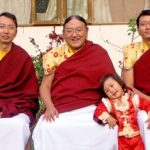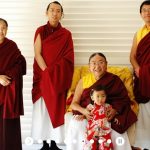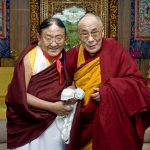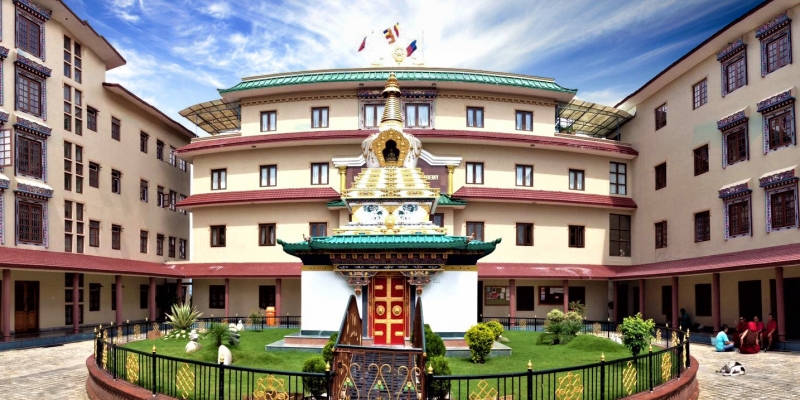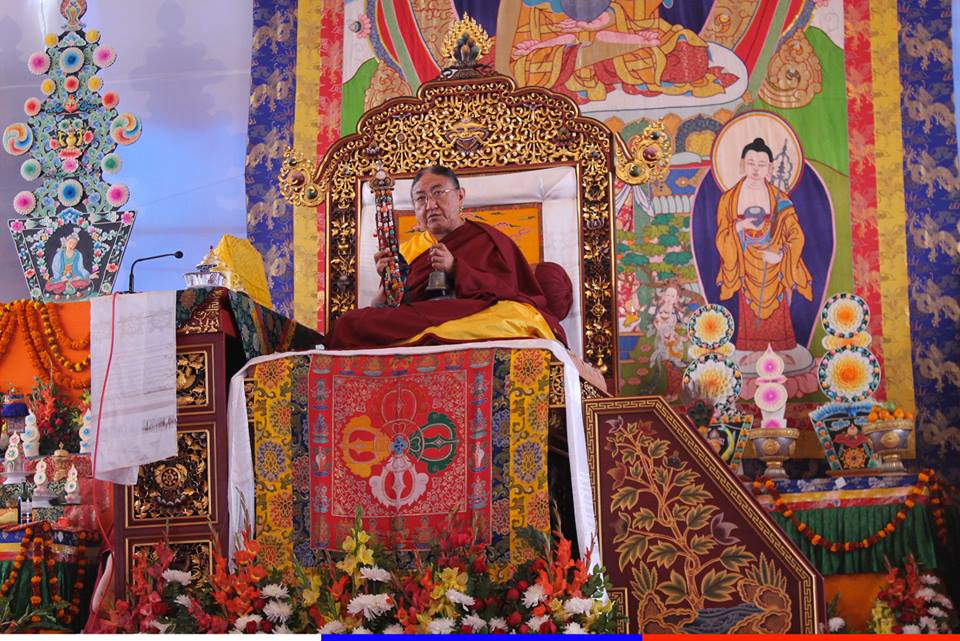HIS HOLINESS SAKYA TRIZIN
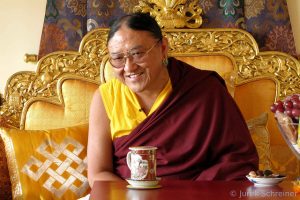 H.H. Sakya Trizin who is considered second only to His holiness the Dalai Lama in the spiritual hierarchy of Tibetan Buddhism was born into the noble family of Tibet, which has led Sakya monastery and its religious tradition for over nine hundred years. His Holiness is distinguished among great Lamas by the vast amount of teachings he has received. He spent most of his time in practicing the Dharma, and he has completed many solitary retreats. He has also taught extensively both in Asia and the West, generously bestowing for the benefit of living beings such major sets of initiations and instructions as the collection of Tantra, collection of Sadhana, and the Path and it Result (Lam-Dre).
H.H. Sakya Trizin who is considered second only to His holiness the Dalai Lama in the spiritual hierarchy of Tibetan Buddhism was born into the noble family of Tibet, which has led Sakya monastery and its religious tradition for over nine hundred years. His Holiness is distinguished among great Lamas by the vast amount of teachings he has received. He spent most of his time in practicing the Dharma, and he has completed many solitary retreats. He has also taught extensively both in Asia and the West, generously bestowing for the benefit of living beings such major sets of initiations and instructions as the collection of Tantra, collection of Sadhana, and the Path and it Result (Lam-Dre).
The first ever Lamdre teaching in Indian soil by His Holiness was given in Sarnath, one of the four holy lands connected to Lord Buddha where Lord Buddha turned the first wheel of Dharma, when His Holiness was only 21 years old. Since then his Holiness has already given Lamdre teaching more than a dozen times at home and abroad.
INTERNATIONAL BUDDHIST ACADEMY, Kathmandu
The International Academy was established by Khenpo Appey Rinpoche , who died in February 2011, in order to uphold and disseminate the Buddha Dharma in general and Sakyapa tradition in particular. The Academy’s primary aim is to expound Buddhist philosophy chiefly to non-Tibetan speaking students both from abroad and within Nepal. His Holiness Sakya Trizin, the supreme head of Sakya Order of Tibetan Buddhism inaugurated the Academy on 1st August 2001 amidst a large congregation. Since it’s inception, the Academy has already conducted a ‚Four Year Course‘ with ‚ThreeMonth’s Semester‘ every year.
The Academy has three principle objectives:
1: To provide teaching on the Buddha Dharma, in English, Chinese and Nepali etc.
2: To translate the works of early Indian and Tibetan scholars currently existing in Tibetan.
3: To convert rare Tibetan manuscripts into digitized format and publish them.
A seven days teaching on „Parting fram the Faur Attachments“ by His Holiness Sakya Trizin and „Hevajra Grand Teaching“ by Khenpo Appey Rinpoche to a large group of Rinpoches, scholars, and monks led by His Eminence Dung-sey Ratna Vajra Rinpoche, His Eminence Drigung Kyabgon Rinpoche and Khyentse Rinpoche; are some of the notable events that took place at IBA’s premises.
More information: http://internationalbuddhistacademy.org/
A BRIEF INTRODUCTION TO SAKYA TRADITION
The Sakya Tradition is one of the four major traditions of Tibetan Buddhism. The word Sakya means ‚grey‘, ‚whitish earth‘ and refers to a patch of white earth in the shape of a lion’s face on the side of Ponpori mountain in Tsang Province, South Western Tibet, where the tradition has its origin. In 1073, Konchok Gyalpo an Aristocratic Khon family constructed a great temple hermitage called the Gorum Zimkyil Karpo at an auspicious location below this white patch of earth making the beginning of the Sakya lineage. This is the basis of the name Sakya.
Legend has it that the dynamic line of Khon descended from the ‚Heavenly Realms‘. Through the centuries, an able luminary of divine (Lharig) Khon family has always headed the Sakya Tradition. In fact, the Sakya Tradition was the first in Tibetan history to gain religious and secular authority over the whole country.
The heart of Sakya Tradition is Lam-Dre (meaning: the Path along with its Result), one of the most comprehensive and systematically organized meditative systems of Buddhism in Tibet. The Lam-Dre which is based on the non-dual Hevajra Tantra originated with the Indian Mahasidha Virupa (837-unknown), and the transmission has continued uninterruptedly down through the Mahasidha and Tibetan translators to the great masters of the SakyaTradition until the present day.
THE MASTERS OF SAKYA
more Information: sakya/sakya-masters
HIS HOLINESS JIGDAL DAGCHEN SAKYA
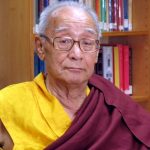 H. H. Jigdal Dagchen Sakya Rinpoche, the founder and principal Guru of Sakya monastery of Tibetan Buddhism in Seattle, WA, was born into the Phuntsok branch of the Khon lineage in 1929 in south Western Tibet. Following many intensive studies and initiations, Rinpoche went into a long series of retreat. He then conferred the Lam-Dre Tsogshey to monks, nuns and lay people of Sakya.
H. H. Jigdal Dagchen Sakya Rinpoche, the founder and principal Guru of Sakya monastery of Tibetan Buddhism in Seattle, WA, was born into the Phuntsok branch of the Khon lineage in 1929 in south Western Tibet. Following many intensive studies and initiations, Rinpoche went into a long series of retreat. He then conferred the Lam-Dre Tsogshey to monks, nuns and lay people of Sakya.
After the passing of his father, Rinpoche traveled to East Tibet where he studied under Dzongsar Khyentse Choekyi Lodroe and Dilgo Khyentse Rinpoche. His Holiness bestowed initiations and teachings throughout East Tibet and established many monasteries and retreat centers in the region.
In 1959 Rinpoche, his wife Dagmo Kusho and their family fled to India. The following year he was invited to participate in a research project on Tibetan civilization at the University of Washington sponsored by a Rockefeller Foundation grant. Rinpoche has been living in Seattle since 1960 with his wife and sons. He works actively to help preserve and share the Tibetan tradition in the West. In 2003, Rinpoche has established a centre in New Delhi for the young Dung-seys of Phuntsok palace as a study hub.
HIS EMINENCE CHOEGYE TRICHEN RINPOCHE
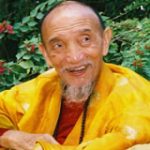 H. E. Choegye Trichen Rinpoche is the head of Tsarpa branch of Sakya Order. He was a renown tantrik master, a dedicated practitioner, an outstanding scholar and an eloquent poet. He was born in 1920, and received his teachings at Nalanda Monastery. Rinpoche died in His monastery in Kathmandu.
H. E. Choegye Trichen Rinpoche is the head of Tsarpa branch of Sakya Order. He was a renown tantrik master, a dedicated practitioner, an outstanding scholar and an eloquent poet. He was born in 1920, and received his teachings at Nalanda Monastery. Rinpoche died in His monastery in Kathmandu.
After leaving Tibet in 1959, he worked as General Secretary of the council of Religious Affairs for the Tibetan Government in Exile for a few years. Thereafter, Rinpoche established monasteries in Lumbini and Kathmandu and the centers in overseas as weIl. Rinpoche has organized a series of three years retreat of Hevajra under his personal guidance and observation. Rinpoche is an accomplished teacher, master of master who has had the honor of offering teachings to His Holiness the Dalai Lama and His Holiness Sakya Trizin. Every winter a large congregation of the Sangha members gather in Lumbini to hold the great Sakya Monlam Festival under the guidance of His Holiness Sakya Trizin and their Eminencies in Tashi Rabten Ling Monastery that was inaugurated early 2004.
In response to repeated entreaties from Lama Choedak Rinpoche and his disciples in Australia, His Eminence kindly gave Vajrayogini teaching in Lumbini which was attended by Western and Nepali followers in number exceeding three hundreds.
LUDING KHENCHEN RINPOCHE TULKU DORJEE DENPA
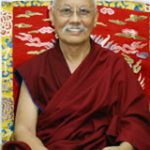 His Eminence Luding Khenchen is the head of the Ngor sub-lineage of the Sakya school of Tibetan Buddhism. He bears the title of Kyabgye, Protector or Chief Refuge.
His Eminence Luding Khenchen is the head of the Ngor sub-lineage of the Sakya school of Tibetan Buddhism. He bears the title of Kyabgye, Protector or Chief Refuge.
His Eminence Luding Khenchen Rinpoche, Jamyang Tenpei Nyima, is one of the most highly respected and learned teachers of the Sakya tradition and of Tibetan Buddhism at large. He is believed to be the emanation of Vajrapani and was born in 1931 to the noble family of Shang, Sharchen or Ludingpa, which is renowned for producing great scholars and siddhas.
At the age of ten, according to the Luding lineage, he was ordained as a monk by his uncle and root guru, the most gracious Khenchen Sharchen Jamyang Thupten Lungtok Gyaltsen Palsangpo. As befitted a major lineage holder, he was given extensive training by the best teachers in the Sakya and other traditions. He undertook innumerable major and minor retreats, practising almost all the deities of the Sakya and the Ngor traditions.
In 1954, a t the age of 24, His Eminence was enthroned as the 75th chief abbot of Ngor Ewan Choedhe Monastery, succeeding his teacher and uncle, the former Ngor Abbot Jamyang Thupten Lungtog Gyaltsen. For 500 years, Ngor Monastery has been the head of hundreds of other branch monasteries, and its school of ritual studies has been the citadel of training and practice of tantric ritual in the Sakya tradition.
The position of the head abbot of Ngor was traditionally held for a three year period, in which extensive teachings are given, almost non-stop, of which Lam Dre and the Seven Mandalas of the Ngor were the main teachings. The three year tenure as chief abbot of Ngor Monastery would normally alternate between four Ngor Houses (Ladrangs): Luding, Khangsar, Thartse and Phende. Since leaving Tibet, due to the disruption to the Ngor monastic system, His Eminence held this post for over 45 years, up to 16 March 2000, when he handed the abbotship to his nephew, His Eminence Luding Khen Rinpoche.
RATNA VAJRA RINPOCHE
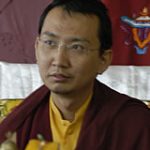 His Eminence Ratna Vajra Rinpoche, eldest son of His Holiness the Sakya Trizin, is one of the most important young lineage holders and a descendant of the Khon family – successive generations of which have continued an unbroken lineage of great and famous masters.
His Eminence Ratna Vajra Rinpoche, eldest son of His Holiness the Sakya Trizin, is one of the most important young lineage holders and a descendant of the Khon family – successive generations of which have continued an unbroken lineage of great and famous masters.
Born on 19 November 1974 in Dehradun, Uttar Pradesh, India, His Eminence was from birth the recipient of blessings, initiations and teachings from many high lamas, including his own father, to increase his capacity for knowledge and wisdom.
In his childhood, he travelled widely in India as well as many other countries with his parents. At the age of six, he began his formal education under the tutorship of Venerable Rinchen Sangpo. In the next few years, he studied Tibetan reading, writing, grammar, memorisation and recitation of basic prayers and rituals. In 1987, when His Eminence was fourteen, he passed his first major examination at the Sakya Centre, Rajpur. Two years later, he completed all his basic studies of different rituals and scriptures at the Sakya Centre.
The following year, he joined the Sakya College and studied there for the next seven years. In 1998, His Eminence finished his Kachupa degree, which is equivalent to a Bachelor’s Degree. During this period, His Eminence received many exoteric and esoteric teachings, empowerments, blessings, initiations, oral transmissions, explanations and pith instructions from his father and also the foremost high lamas and scholars of this age, such as His Holiness the 14th Dalai Lama, His Eminences Chogye Trichen Rinpoche and Luding Khenchen Rinpoche.
His Eminence has accompanied His Holiness the Sakya Trizin on many teaching tours around the world. He has given many teachings and initiations in India and abroad and has also done many retreats on the principal deities of the Sakyapa order. Presently, he stays at the Sakya Dolma Phodrang, the palace of His Holiness the Sakya Trizin, and accompanies His Holiness on various tours in India and abroad and also participates in regular prayer ceremonies at Sakya Centre and Dolma Phodrang. He is widely regarded as a learned scholar of the Sakya tradition and speaks English fluently.
His Eminence Ratna Vajra Rinpoche, being the elder son of His Holiness the Sakya Trizin, is the lineage holder and on 12 September 2002, His Eminence married Dagmo Kalden Dunkyi, the daughter of Mr Lundrup Topden and Mrs Yangchen Drolkar at Sakya Dolma Phodrang. In accordance with Sakya tradition the marriage was kept secret for a certain period of time and only the closest relatives of the bride and groom attended. Their firstborn daughter Jetsunma Kunga Trinley Palter Sakya was born on 2 January 2007, on the Parinirvana Day of Sakya Pandita, thus receiving a very auspicious head start in life.
GYANA VAJRA RINPOCHE
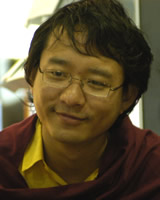 His Eminence Khöndung Gyana Vajra Rinpoche, youngest son of His Holiness the Sakya Trizin, was born on 5 July 1979 in Dehradun, Uttar Pradesh, India. During his childhood, together with his elder brother, His Eminence Khöndung Ratna Vajra Rinpoche, His Eminence studied religious text, reading, writing, grammar, memorisation of important prayers and rituals under the tutorship of Venerable Rinchen Sangpo.
His Eminence Khöndung Gyana Vajra Rinpoche, youngest son of His Holiness the Sakya Trizin, was born on 5 July 1979 in Dehradun, Uttar Pradesh, India. During his childhood, together with his elder brother, His Eminence Khöndung Ratna Vajra Rinpoche, His Eminence studied religious text, reading, writing, grammar, memorisation of important prayers and rituals under the tutorship of Venerable Rinchen Sangpo.
His Eminence then joined Sakya Centre, the main monastery and seat of His Holiness the Sakya Trizin, where he learned all the basic rituals and prayers. Following the completion of his studies and training at Sakya Centre he joined Sakya College and furthered his studies in Buddhist philosophy for next five years. During this period, he often participated in the religious ceremonies held annually at the Sakya Centre. He has also received many major initiations, common and uncommon teachings from His Holiness.
In all, he received decades of rigorous training from His Holiness himself, as well as many other lamas such as the late His Eminence Chogye Trichen Rinpoche, His Eminence Luding Khen Rinpoche, Khenpo Appey Rinpoche, and the late Khenpo Migmar Rinpoche. His Eminence has accompanied His Holiness during many of his teaching tours throughout India and abroad, and recently returned to lay life. His Eminence Gyana Vajra Rinpoche married Dagmo Sonam Palkyi on 21 April 2008.
EMINENCE LUDING KHEN RINPOCHE
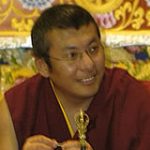 His Eminence Luding Khen Rinpoche is an excellently qualified, wise and compassionate Dharma teacher, and a member of one of the great families of Tibetan Buddhism. His mother is Her Eminence Sakya Jetsun Chimey Luding, the sister of His Holiness the Sakya Trizin, and his father is Sei Kushog, the brother of His Eminence Luding Khenchen Rinpoche, the former abbot of Ngor Monastery.
His Eminence Luding Khen Rinpoche is an excellently qualified, wise and compassionate Dharma teacher, and a member of one of the great families of Tibetan Buddhism. His mother is Her Eminence Sakya Jetsun Chimey Luding, the sister of His Holiness the Sakya Trizin, and his father is Sei Kushog, the brother of His Eminence Luding Khenchen Rinpoche, the former abbot of Ngor Monastery.
As a child, His Eminence Luding Khen Rinpoche was selected to be trained as the successor to the abbot of the Ngor Monastery and was sent to Ngor Monastery in Manduwalla, India to undergo the rigorous training that is a prerequisite for lineage holders. For the next two decades, he trained intensively under the daily tutelage of then senior Ngor abbot His Eminence Luding Khenchen Rinpoche, Jamyang Tenpei Nyima. He also received many teachings and empowerments directly from His Holiness the Sakya Trizin.
His Eminence’s training as a lineage holder included all of the common and uncommon teachings of the Sakya tradition. From the tantra, he studied and mastered the precious Lam Dre teaching, the Collection of All the Tantras, Collection of All the Sadhanas and many others, and accomplished all of the many retreats required for a vajra master. From the sutra, he spent many years at Sakya College studying religious philosophy under the direction of the famous Khenpo Migmar Tsering. As a result, His Eminence is exceptionally well trained in both tantra and sutra.
TULKU DORJEE DENPA
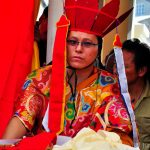 Tulku Dorjee Denpa is the head of Dzongpa tradition of Sakya Order. He was recognized and verified unanimously by His Holiness the Dalai Lama and His Holiness Sakya Trizin as the reincarnation of the Great Omniscience Dorjee Denpa Kunga Namgyal. He received Sharmana ordination from His Holiness the Dalai Lama and novice vow from His Eminence Luding Khenchen Rinpoche. Similarly he received Bikchu ordination from His eminence Chogye Trichen Rinpoche.
Tulku Dorjee Denpa is the head of Dzongpa tradition of Sakya Order. He was recognized and verified unanimously by His Holiness the Dalai Lama and His Holiness Sakya Trizin as the reincarnation of the Great Omniscience Dorjee Denpa Kunga Namgyal. He received Sharmana ordination from His Holiness the Dalai Lama and novice vow from His Eminence Luding Khenchen Rinpoche. Similarly he received Bikchu ordination from His eminence Chogye Trichen Rinpoche.
After completing studies on monastic rituals, he joined Sakya College and studied under weIl known Sakya scholar late Khenpo Migmar. He had completed the study of major sciences of Buddhist philosophy in a lang period of nine years and was honored with Kachupa (B.A) and Lhoppon (M.A) degrees. With the dynamic direction of His Holiness the Dalai Lama and kind supervision from His Holiness Sakya Trizin, Rinpoche has successfully completed the construction of Gongkar Seat in exile at the place called Khera Gaon in Dehradun region. At present Rinpoche lives in Khera Gaon with over sixty monks with more than half of them graduates from Sakya philosophical Institutes. His monastery hosts a large number of professional artist monks coming from different field of arts.
THE FIFE SAKYA FOUNDERS
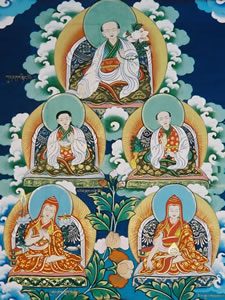 Following the founding of the Sakya order in 1073, the Sakya tradition rose to prominence in Tibet in the 12th and 13th centuries through the efforts of five great Sakya masters. These five masters – known as ‚Jetsun Gongma Nga‘ – are regarded as the real founders of the Sakya tradition.
Following the founding of the Sakya order in 1073, the Sakya tradition rose to prominence in Tibet in the 12th and 13th centuries through the efforts of five great Sakya masters. These five masters – known as ‚Jetsun Gongma Nga‘ – are regarded as the real founders of the Sakya tradition.
Sachen Kunga Nyingpo, the son of Khon Konchok Gyalpo. Through his efforts, hundreds of sutras and tantras as well as oral instructions were gathered and became the basis for the Sakya canon. He brought the precious Lam Dre teachings and Mahakala practice into the Sakya order, and firmly established the Sakya tradition of great learning and meditation.
At the age of twelve, on the instruction of his guru, he performed six months of single-pointed practice until Manjushri appeared to him and gave him the famous four line instruction known as „Parting from the Four Attachments“. Realising instantly that all the points of the path of perfections were contained in those four lines, he became an emanation of Manjushri and needed to hear a teaching only once in order to realise its profound meaning.
Parting from the Four Attachments:
If you are attached to this life, you are not a person of Dharma.
If you are attached to cyclic existence, you do not have renunciation.
If you are attached to your own purpose, you do not have bodhichitta.
If grasping arises, you do not have the view.
Loppon Sonam Tsemo who succeeded Sachen Kunga Nyingpo as the fourth patriarch of the Sakya school. By the time he was 18, his reputation for learning had spread far and wide and he had mastered the threefold training of teaching, debate and composition. He taught both the sutra and tantra skilfully according to the needs of each disciple. He was a great scholar and, through long periods of intensive meditation, he attained the highest stage of realisation.
Jetsun Dakpa Gyaltsen, the fifth patriarch of the Sakya school. He was a prolific writer, and as in all his deeds, the focus of his compositions was the benefit of all beings. He became a celebrated scholar, capable of extinguishing all doubt concerning the profound view. He achieved high realisations and whatever he received he offered to the gurus and the Triple Gem, or gave to those in poverty.
Sakya Pandita, the sixth patriarch of the Sakya order, who was the most famous of all for his knowledge and scholasticism which spread as far as Mongolia and China. His intellect was unmatched, he realised the meaning of every scripture exactly and correctly, all of his speech was flawless, and his statements faultless.
Chogyal Phakpa, the seventh throneholder and the nephew of Sakya Pandita. During his time, the Sakya tradition flourished with the introduction of Mahayana Buddhism into China and Mongolia. Throughout his life, Chogyal Phagpa engaged in many activities such as preaching the Dharma and building great monasteries. He ordained thousands of monks each year and worked diligently for the benefit of the Buddha’s doctrine and for sentient beings.
After them, there were the Six Ornaments of Tibet: Yakton Sangye Pal, Rongton Sheja Kunrig, Ngorchen Kunga Zangpo, Dzongpa Kunga Namgyal, Gorampa Sonam Senge and Shakya Chogden.
SACHEN KUNGA NYINGPO
The great Sakyapa Kunga Nyingpo (1092-1158) son of Khon Konchok Gyalpo, mastered all the Sutra and Tantra teachings originally transmitted by the Sages and Siddhas in India.
At the age of 12, following the instruction of his Guru Bari Lotsawa, he performed six months of one pointed practice until Manjushri appeared to him and gave him the famous four line instruction widely known as ‚Parting from the Four Attachments‘. Sachen Kunga Nyinpo then realized instantly that all the points of the path of perfections were contained in those four line teaching. Sachen being an emanation of Manjushri, needed only to hear a teaching once in order to realize its profound meaning.
He was a man of immeasurable virtue who did not fringe the three vows in any way and whose uncontrived Bodhichitta was all embracing. As he was able to unite the two stages of meditation he had passed beyond all limitation and overwhelmed his teachers by his practice and his faith. He had realized all the inner signs of accomplishment, encountered the deities and possessed the gift of clairvoyance. His many other attributes included the ability to teach dharma and give consecration by appearing in many places simultaneously in six different forms. His realization equaled that of the great Buddhist sages of India. At the age of 67, his four emanations departed for four pure lands to benefit sentient beings.
THE LAMDRE LOB-SHED LINEAGE
1. Virupa
2. Krishnapa
3. Damarupa
4. Avadhutipa
5. Gayadhara 0694-1043
6. Drokmi Lotsawa 0992-1072
7. Seton Kunrig 1025-1113
8. Shangton Choebhar 1053-1136
9. Sachen Kunga Nyingpo 1092-1158
10. Loppon Sonam Tsemo 1142-1182
11. Jetsu Drakpa Gyaltsen 1147-1216
12. Sakya Pandita 1182-1251
13. Choegyal Phakpa 1235-1280
14. Shang Konchok Pal 1240-1308
15. Naza Drakphugpa 1277-1350
16.. Lama Dhampa Sonam Gyaltsen 1312-1375
17. Lama Palden Tsultrim 1333-1399
18. Buddha Shree 1339-1419
19. Ngorchen Kunga Sangpo 1382-1456
20. Muchen Sempa Chenpo 1388-1469
21. Dhagchen Lodue Gyaltsen 1444-1495
22. Doring Kun Pangpa Chenpo 1449-1525
23. Tsarchen Losal Gyatso 1502-1566
24. Jmayang Khyentse Wangchuk 1524-1566
25. Khenchen Labsum Gyaltsen 1526-1577
26. Dorje Chang Wangchuk Rabten 1559-1636
27. Gonpo Sonam Chogdhen 1603-1659
28. Rinchen Sonam Chokdrup 1602-1681
29. Khyenrab Jampa 1633-1703
30. Morchen Kunga Lhundrup 1654-1728
31. Nesarwa Kunga Lekpa 1704-1761
32. Sachen Kunga Lodroe 1729-1783
33. Jampa Namkha Chemi 1765-1820
34. Jampa Kunga Tenzin 1776-1862
35. Jampa Kunga Tenpei Gyaltsen 1829-1870
36a Ngawang Sonam Gyaltsen 1830- 1890
37a. Ngawang Lodroe Nyingpo 1840-
38a. Ngawang Lodroe Shenphen Nyingpo 1876-1953
39a. His Holiness Sakya Trizin 1945
39b. Jamgon Loter Wangpo 1847-1914
37b. Dakpa Choekyi Nyima
38b. Ngawang Lodroe Seh“nphen Nyingpo 1876-1953
39b. His Holiness Sakya Trizin 1945
SONAM TSEMO
Sachen Kunga Nyingpo’s son, the great pandita Acharya Sonam Tsemo, master of the five sciences, was born in the Water Dogyear of second cycle (1142). His birth was announced by Dakinis who wrote the letters „Khau Shambhi Pandita Devamati“ on the temple door of Vajrasana now Bodhgaya. In India he was acclaimed as an incarnation of Durjaya Chandra.
Sonam Tsemo obtained all the-empowerments, explanations and oral instructions from Sachen Kunga Nyingpo. For eleven years he studied with Chawa Choe-kyi Senge at Sangphu.
On top of receiving empowerments, explanations and oral instructions from Sachen Kunga Nyingpo, his studies included teaching on the Paramita, Madhyamika, Pramana, Vinaya and Abhidharma. By the time he was 18, his reputation for learning had spread beyond the Ganges and he had mastered the three fold training of teaching,debate and composition.
He was able to transfer himself at will to certain spiritual land such as Oddhiyana and Potala and attained the highest virtues, reaching the level of a Bodhisattva of the second Bhumi. In the male Water Tiger year (1182) when he was forty one years of age, the air filled with a pleasant perfume and the sounds of cymbals as he was giving a teaching to eighty advanced students, and he obtained the rainbow body vanishing in a cloud of light.
THE LAMDRE TSOGSHED LINEAGE
1. Virupa 0837-0909
Realization 897 C.E.
2. Krishnapa
3. Damarupa
4. Avadhutipa
5. Gayadhara 0694-1043
6. Drokmi Lotsawa 0992-1072
7. Seton Kunrig 1025-1130
8. Shangton Choebhar 1053-1136
9. Sachen Kunga Nyingpo 1092-1158
10. Loppon Sonam Tsemo 1142-1182
11. Jetsu Drakpa Gyaltsen 1147-1216
12. Sakya Pandita 1182-1251
13. Choegyal Phakpa 1235-1280
14. Shang Konchok Pal 1240-1308
15. Naza Drakphugpa 1277-1350
16. Lama Dhampa Sonam Gyaltsen 1312-1375
17. Lama Palden Tsultrim 1333-1399
18. Buddha Shree 1339-1419
19. Ngorchen Kunga Sangpo 1382-1456
20. Muchen Sempa Chenpo 1388-1461
21. Gyaltsab Kunga Wangchuk 1418-1462
22. Gorampa Sonam Senghe 1429-1489
23. Konchok Phel 1445-1514
24. Sang-gye Rinchen 1453-1524
25. Salo Jampal Dorjee 1485-1553
26. Konchog Lhundrup 1497-1557
27. Ngawang Kunga Rinchen 1517-1558
28. Konchog Gyamtso 1510-1586
29. Jmayang Sonam Wangpo 1559-1621
30. Drakpa Lodroe 1563-1617
31. Muchen Sang-gye Gyaltsen 1573-1618
32. Jamgon Amay Shab Kunga Sonam 1597-1659
33. Sonam Wangchuk 1638-1685
34. Kunga Tashi 1656-1711
35. Sonam Rinchen 1705-1741
36. Ngawang Kunga Lodroe 1729-1783
37. Ngarig Kunga Tashi 1754-1817
38. Pema Dudhul Wangchuk 1792-1853
39. Ngawang Kunga Gyaltsen 1803-1841
40. Tashi Rinchen 1823-1865
41. Kunga Nyingpo Samphel Norbu 1850-1899
42. Dagshul Trinlay Rinchen 1871-1936
43. Khenchen Jampal Sangpo 1901-1961
JETSUN DAKPA GYALTSEN
Jetsun Dakpa Gyaltsen was born in the Fire Hare year ofthe third cycle (1147). Endowed with the unceasing inspiration of Arya Manjushri hedisplayed his profound view and vast activity which encompassed the teaching of the Tripitaka and all the Tantras. He became a celebrated scholar, saint and Yogin capable of extinguishing all doubt concerning the profound meaning.
When the famaus Khache Penchen (1126-1225) an kilIed astrologer, announced of an eclipse of the sun, Dakpa Gyaltsen with intention to trick him ,stopped the movement of breath-rilind in the right and left channels of the subtle body and caused the ‚Red‘ and ‚White‘ drops to mix in the central channel. The eclipse was prevented by this yogic practice. The pandita knowing this was Dakpa Gyaltsen’s work, went to visit him. Upon his arrival, Dakpa Gyaltsen sprang to his feet and suspended his vajra and bell in mid-air. When he saw this miracle, Khache Penchen exclaimed: ‚Great Vajradhara‘. Realizing that this was the most precious of all the Vajra holders, he requested the nectar of his teaching.
Dakpa Gyaltsen had the power to transfer himself to different spiritual lands to benefit all beings. He prophesied that when he will reborn as a Chakravartin emperor in the ‚Gold Colored World‘, he would realize the majority of the paths and Grounds and would become a perfectly accomplished Buddha after only three more incarnations.
SAKYA PANDITA
Sakya Pandita was born in the Water Tiger year of the third Cycle (1182) as the son of Palchen Odpo, brother of Dakpa Gyaltsen. Like the Buddha he made five choices before incarnating. He entered the womb in the form of a Naga King, head decorated with precious jewels. During this time his mother experienced a depth of meditation previously unknown to her. When he was born, a great light filled the sky and he began to speak in Sanskrit. It was impossible for those who beheld him to tear their gaze from his face.
In the year, 1199 when Sa-pan was eighteen he had two dreams that forecast his future greatness as scholar. One dream was that a monk named Vasubhandu was expounding the Abhidharmakosha before the great Achi Stupa at Sakya, and Sapan himself was seated there, listening reverently to the exposition. In the second dream he dreamt that he was at a very pleasant place called ‚Dignaga’s. Cave‘ eastern India. There he was given the key to many volumes of scripture on Pramana, including the Pramanasamucaya and the seven treaties of Dharmakriti. Sa-pan’s later biographers attached a great significance to these dreams, as Abhidharma and Pramana were indeed two subjects in which he excelled widely as a mature scholar.
In the Iron Pig year (1251) at the age of 70, he passed away in to the spiritual land of joy whilst residing at the ‚magical temple monastery‘, having traversed the five path and the ten Boddhisattva Bhumis.
CHOEGYAL PHAKPA
Drogon Chogyal Phakpa, the son of Zangtsa, Sakya Pandita’sbrother was born in the wood Sheep year of the second cycle (1253). When he was eight years old, he gave a great teaching on the He-Vajra tantra to a thousand monks. Those who listened to him developed immense faith in him. He was termed the ‚Noble‘ one (phagpa). Sechen, the MongoI emperor, invited him to China to carry out great works for the benefit of Dharma and all sentient beings. He ordained thousands of monks each year. Through his skills in debate he defeated the nonBuddhist views of the seven masters of Zin-shing, who had previously criticized)the Buddha’s teaching and converted them to Buddhisrn. With request from the King Gose, he compiled MongoI Alphabets.
In response to entreaties by his Chinese students he performed a miracle to display the power of Sakya teachings. He took a sharp weapon and cut off his head and limbs. These five pieces were transformed into the five Buddha families and were seen to send out countless rays of light:. As the Buddha had prophesied in the Manjushrimula Tantra he became the first Tibetan Lama to be a king arid governed impartially as far as the different schools of Buddhism were concerned.
SAKYA-SCHOOL of TSARPA
The Dhar Drangmoehen Monastery in Tsang was the residenee of the Tsarehen Vjaradhara Losal Gyatso (b.1494). The Tsarpa tradition was famed for its transmission of the Thirteen Golden Teachings (gSer-Chos beu-gsum) and teachings on the greater and lesser Mahakala. The teachings had been transmitted through Ngorehen and his prineipal diseiples and through the divine Khon line. They were passed on without interruption until Vajradhara Lodoe Gyatso who gave them to Doringpa Kunpang Chenpo who reeeived them in the manner of a vase filled at brim. From Tsarehen Dharmaraja who reeeived teachings directly from Vajra Yogini up to the present Head of Tsarpa tradition, His Eminenee Chogye Trichen Rinpoche, the esoterie teaching widely spread. Thus the esoterie teaching has been a guide to the fortunate beings aspiring for the immaeuiate result of Buddahood. The Tsarpa seat lies in Nalanda two hours drivirig distanee from North East of Lhasa.
SAKYA MONLAM FESTIVAL
The Sakya Monlam Festival has history of 12 years. Until 2004, the Monlam Festival was held in Lumbini at old Sakya monastery. The Molam Prayer is performed for World Peace and prosperity.
During the ten day long Monlam Festival the chanting of one hundred thousand Samantabadhra prayer along with Manjushrinamasangita is accomplished. The generous endeavor of Dharthang Tulku Rinpoche made it possible to get the concealed inspiration of the Sakya Rinpoche revealed.
It was 1993 that the Great Sakya Monlam Festival was flagged off under the initiative of His Eminence Chogye Trichen Rinpoche. The number of the attendance to the Monlam Festival kept on increasing every passing year. However, the old Sakya monastery in Lumbini is no longer adequate to provide sufficient and suitable accommodation for all the high Lamas and participants involved in such a Festival. For this reason it was necessary to improve the facilities available in Lumbini. After serious consideration, His Eminence Chogye Trichen Rinpoche made ‚a decision to build new accommodation. Every year a long life Mandala is offered to His Eminence Chogye Trichen Rinpoche at the end of Sakya Monlam Festival. This unique event is attended by a large flocks of lay pilgrims from the nearby towns and cities.

